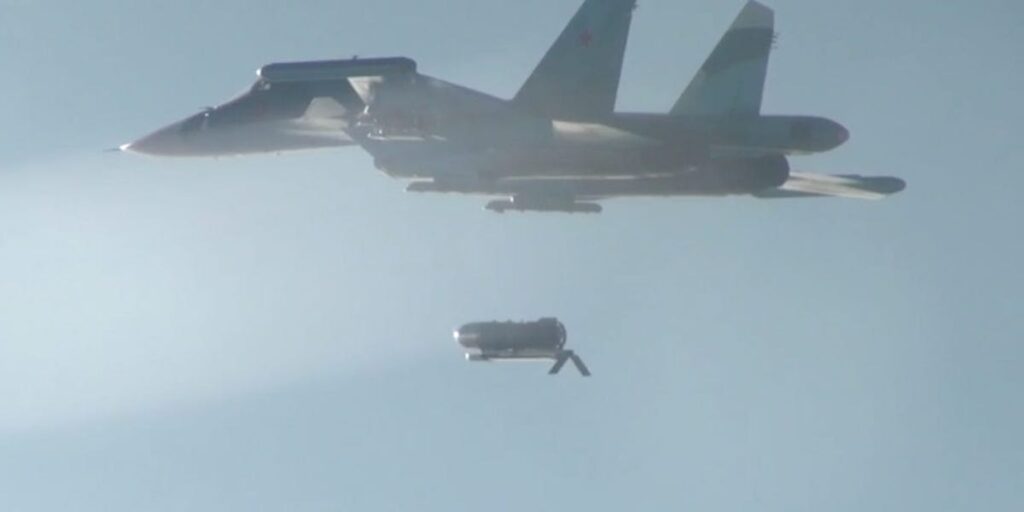
Ukrainian forces have launched a significant attack on a Russian airbase, Marinovka, located in the Volgograd region, over 270 miles from the front lines. This strike, carried out using long-range drones on Friday, resulted in the destruction of at least two Su-34 fighter-bomber aircraft, according to a new Western intelligence assessment.
The Marinovka airbase serves as a strategic fallback location for Russian fighter jets, particularly those relocated from more vulnerable positions. Britain’s defense ministry confirmed details of the attack in a Tuesday intelligence update, noting that the base is used for daily combat operations and as a refuge for aircraft transferred from threatened airbases.
Strategic Significance of the Marinovka Strike
The Su-34 fighter-bomber aircraft, known for carrying highly destructive glide bombs, were moved to Marinovka from the Morozovsk airbase, which lies closer to the conflict’s front lines. This relocation followed a Ukrainian drone attack on Morozovsk in August 2024. Despite these efforts to protect their aircraft, the British defense ministry stated that “Russian aviation remains vulnerable” to Ukrainian attacks.
The attack on Marinovka was a coordinated operation involving Ukraine’s SBU internal security agency, Special Operations Forces, and other military elements. The SBU reported the destruction of two Su-34s and damage to two additional aircraft, while the Ukrainian military claimed all four planes were destroyed. The drone strikes also ignited fires in the airbase’s maintenance and repair areas.
The Threat of Glide Bombs
The Su-34 “Fullback” fleet poses a significant challenge for Ukraine due to its deployment of glide bombs, which are unguided bombs equipped with kits that transform them into precision-guided munitions. These bombs are difficult to intercept due to their short flight times, small radar signatures, and non-ballistic trajectories. They have been used in devastating strikes against Ukrainian cities.
Russia’s defense industry produces glide bombs in various sizes, with some weighing over 6,000 pounds, causing massive destruction upon impact. Britain’s defense ministry highlighted that Russia relies heavily on its Su-34 fleet to conduct “huge amounts of daily sorties launching glide bombs” across the front lines. Since the full-scale invasion began in February 2022, Moscow has reportedly lost over 30 of these aircraft.
Ukraine has prioritized curbing the glide bomb threat, executing numerous deep strikes over the past year targeting Su-34 aircraft, their airbases, and munitions storage sites.
Ongoing Efforts to Degrade Russian Capabilities
The attack on Marinovka is part of Ukraine’s relentless campaign to weaken Russian aviation capabilities. Over the weekend, Kyiv conducted another drone strike targeting helicopter operations at a base in the occupied Crimean peninsula. These actions underscore Ukraine’s strategic focus on diminishing Russia’s aerial threat.
Ukrainian President Volodymyr Zelenskyy recently highlighted the ongoing challenge posed by glide bombs, noting that Russian warplanes had launched nearly 1,100 of these munitions in the previous week alone. This statistic underscores the persistent threat that these weapons pose to Ukrainian forces and civilian areas.
Implications and Future Outlook
The successful strike on Marinovka not only demonstrates Ukraine’s growing capability to conduct deep strikes but also highlights the ongoing vulnerability of Russian air operations. As Ukraine continues its efforts to counter the glide bomb threat, the conflict’s aerial dimension remains a critical focus for both sides.
Looking ahead, the international community will be closely monitoring the developments in the region. The continued exchange of strikes and counter-strikes could escalate tensions further, potentially drawing in broader geopolitical implications. The situation remains fluid, with both Ukraine and Russia adapting their strategies in response to evolving battlefield dynamics.
As the conflict persists, the resilience and adaptability of both Ukrainian and Russian forces will play a crucial role in shaping the future trajectory of the war. The international community’s response, particularly in terms of support and diplomatic efforts, will also be pivotal in influencing the conflict’s outcome.





